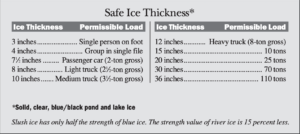2023-Feb-10
No Ice is Safe Ice!
According to the Insurance Bureau of Canada between 25 and 30 Canadians die in ice-related incidents each year and many more must be rescued. Mild temperatures this winter have made ice conditions very unpredictable and no ice is safe ice especially when temperatures have not been cold enough for long enough to form thick ice. It can take many consecutive days of sub-zero temperatures to form ice that is thick enough to venture out on. Even if the ice is thick enough to venture out on, there are still considerable risks.
No Ice is Safe Ice!
Don’t overestimate the strength or quality of ice! Always, always use extreme caution if you are venturing out on a frozen lake. Before you go, there are three key steps to perform to assess the safety of the ice:
Complete a Visual Inspection
- Look for:
- cracks, breaks, holes in the ice or flowing water
- water sitting on top of the ice
- ice that appears soft or mushy
- ice that appears to have thawed and refrozen
If you see any of these signs during your visual inspection, do not go out onto the ice!
It’s important to remember too that logs and rocks absorb the heat from the sun, which may result in faster melting and slower formation of ice in those areas.
Check the Ice Colour
There are three distinct colours of ice which can be indicators of the ice’s strength:
- Blue ice
- Blue ice is clear and is generally the strongest ice
- The ice colour deepens with increasing thickness
- It usually forms when the temperatures drop below minus 8°C
- White ice (opaque or snow ice)
- White ice is generally only half as strong as blue ice
- It is often formed when snow or water freeze on top of existing ice
- When this forms, it can take even longer for the lower-level ice to solidify making it less safe
- Grey ice
- Dull grey is a sure sign of unsafe ice
- A grey colour means that water is present, and the ice will NOT support much weight
- Grey ice is very common in the spring and in faster moving water all winter long
Measure the Thickness of the Ice
This is the crucial final step. When testing ice thickness:
- Do not test alone – always ensure you’re using the buddy system!
- Chip the ice to create a small hole and then measure the thickness of the ice with a tape measure
The Old Farmer’s Almanac suggests that ice must be over 3 inches (10 cm) thick to carry a single person and over 6 inches (15 cm) thick to support a snowmobile.

The Old Farmer’s Almanac
**Always keep in mind when you move around the ice that thickness does vary, so check the depth of the ice often.
If you’ve assessed the ice and are venturing out, you should always:
 Check with local authorities for warnings about unsafe conditions
Check with local authorities for warnings about unsafe conditions- Watch the weather, as temperature fluctuations and precipitation may soften the ice
- Never travel on ice alone and always ensure you have told someone where you are planning to go and your return time
- Keep away from unfamiliar paths or unknown ice and avoid traveling on ice at night
- Wear appropriate clothing and bring proper equipment for safety and comfort
- Avoid slushy ice, untracked ice or ice near moving waters or dock bubblers
- Avoid alcohol
Additional Articles and Resources:
